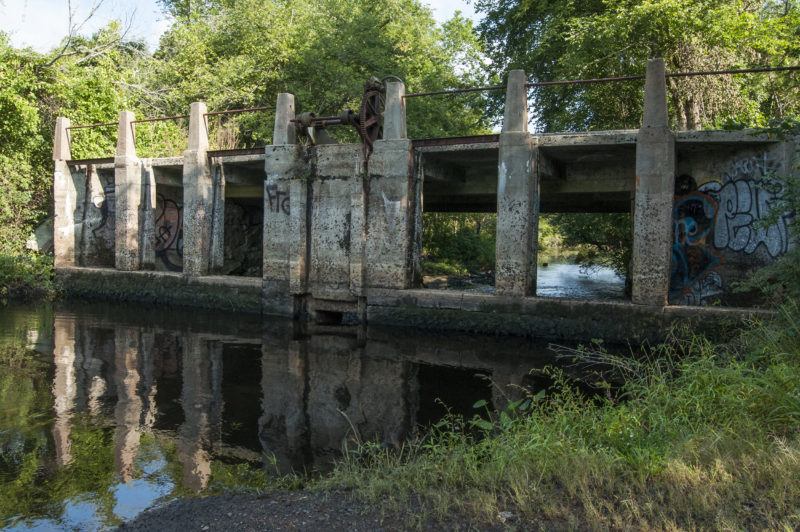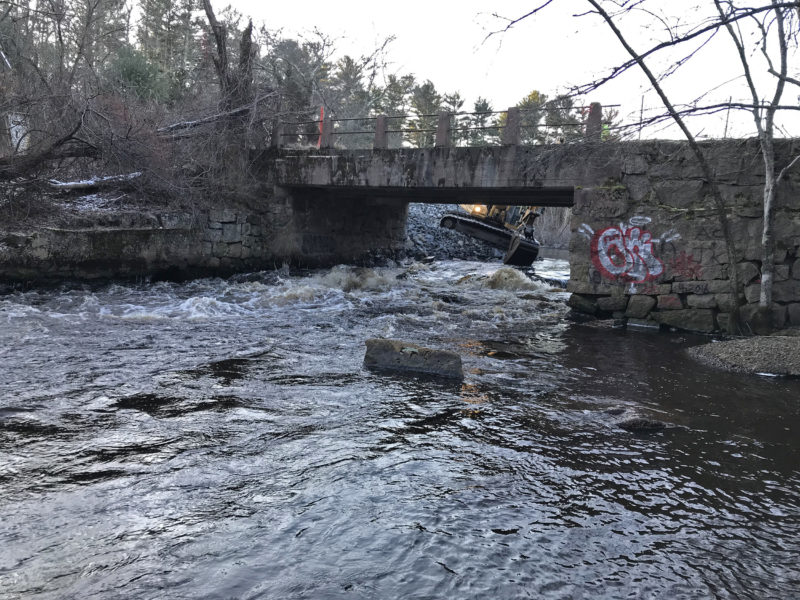Horseshoe Mill dam comes down, opening over 3 miles of fish habitat on the Weweantic River
This spring, the Weweantic River will be the site of an event that hasn’t happened there in nearly 200 years: migratory fish will swim unimpeded from Buzzards Bay to lay their eggs in fresh water upstream. That’s because the Buzzards Bay Coalition is removing a crumbling dam, the remnants of a 19th-century iron works, at our Horseshoe Mill property in Wareham.

For nearly two centuries, this old dam made it difficult for river herring and other migratory fish to swim upstream into their freshwater breeding habitat.
Contractors from Luciano’s Excavation, Inc. took on the task of removing this barrier starting this December. This process was carefully choreographed by the ecological engineering firm Princeton Hydro to minimize any impact on river habitat downstream, including controlling the release of built-up sediment behind the dam as we removed its concrete columns and inoperative spillway.
Despite the effects of the former dam, the Weweantic — the Bay’s largest freshwater river — is still home to the most diverse community of migratory fish that remains anywhere on Buzzards Bay. The removal of the dam will provide more than three miles of habitat for fish like river herring, white perch, and rainbow smelt, which swim upstream from the salt water of Buzzards Bay in order to breed in fresh water.
Significant funding for the complicated Horseshoe Dam project comes from the Bouchard 120 Natural Resource Damage Trustee Council, a federal-state entity comprised of the US Fish & Wildlife Service, National Oceanic and Atmospheric Administration, the State of Rhode Island and the Commonwealth of Massachusetts. The B120 Trustees are charged with investing penalty funds related to the 2003 oil spill in Buzzards Bay to restore and replace natural resources harmed by the spill. In addition, the MA Department of Conservation & Recreation’s Trails Program, MA DMF’s Recreational Fishing Access Program, and the Massachusetts Environmental Trust have all contributed funding to the project.
We’ve already seen the positive impact that these projects can have for fish. After lowering another old dam at The Sawmill in Acushnet and constructing a more natural fishway, we saw river herring populations dramatically increase.

The bridge at Horseshoe Mill following the dam’s removal.
This removal will also allow the Weweantic itself to revert to the ecosystem that existed there two centuries ago. The old dam sat at the river’s head of tide, where salt water pushed from the Bay by the tide meets fresh water flowing from the river’s headwaters in Carver and Middleborough. The ecosystems that form at these places, shaped by the constant flux of salt and fresh water, are home to rare plants that cannot live anywhere else. With the flow of the tide returned to its natural level, we hope to see rare species that we’ve found further downstream move into this prime new habitat.
The restoration of this natural flow also strengthens this ecosystem against climate change, by providing room for brackish ecosystems and cold-water species — like rainbow smelt — to move upstream as waters warm and sea levels rise.
Over the winter and spring, we’ll continue working at Horseshoe Mill to refurbish the old bridge and improve the property’s trail system. The Coalition will also be installing two new kayak launches: one downstream of the former dam, and one at the mouth of the dam’s old raceway, the smaller concrete channel you see on the east side of the bridge. Just like the fish that call this river home, paddlers will soon be able to view the beauty of the Weweantic unhampered by obstructions. That’s the very reason we protected the Horseshoe Mill site in 2012: so that wildlife and people alike could experience the full potential of this important river.